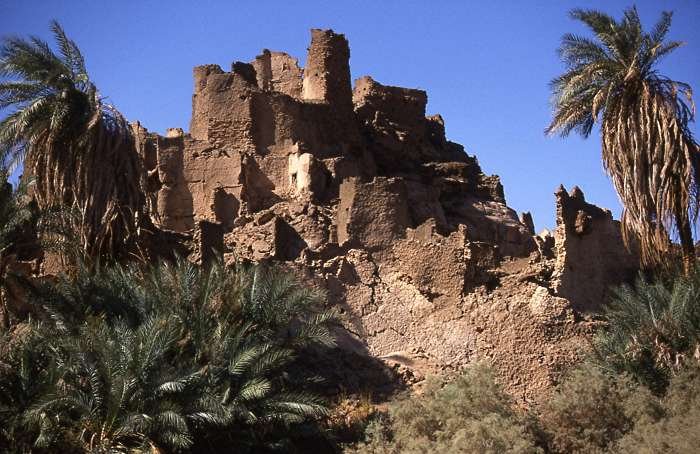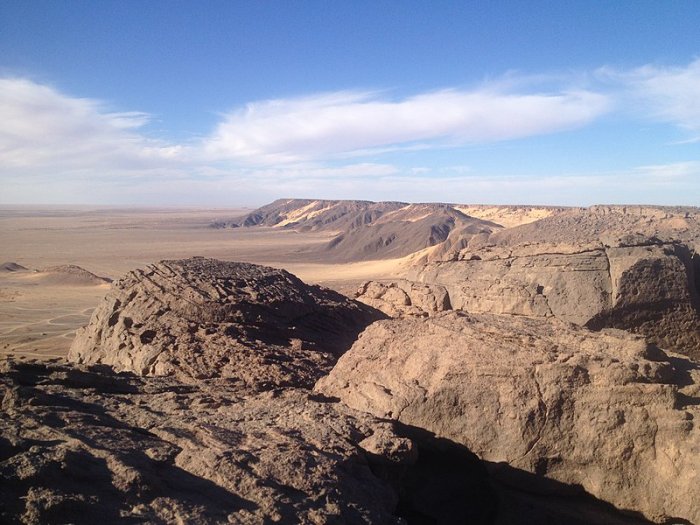Mysterious Ancient Fortified City Of Djado On Dangerous Journey Across Sahara
A. Sutherland - AncientPages.com -There is a mysterious ancient city of Djado located on the southern border of the Djado plateau in northeastern Niger. Once, there were several cities on this plateau, but today, the area is largely uninhabited.
The ruins of abandoned cities, forts, and beautiful cave art are still there.
The Djado Plateau in the northeast is also rich in art, where remarkable paintings and engravings have been discovered in the Aïr Mountains.
Dated back to 3,500 to 2,500 BC, rock art depicts vegetation and animal presence somewhat different from our modern expectations. The remote northeastern town of Djado, a very ancient fortified complex, was a fort and trading center located along the routes towards Libya.
Ruins of the clay construction houses of Djado, the city abandoned centuries ago in the north-east of Niger. Image credit: Holger Reineccius - CC BY-SA 2.0 DE
On the other hand, archaeologists estimate that Djado was built approximately 800-1,000 ago, and it was an oasis and an important station on the dangerous route across the Sahara Desert.
Prehistory and even more modern history of this region have yet to be discovered.
Today, Djado is a ghost town in Bilma, an oasis town and commune in northeast Niger, with, as of the 2012 census, a total population of 4,016 people.
It has good protection from the desert dunes under the Kaouar Cliffs and is the largest town along the Kaouar escarpment. It is known for its gardens, salt, and natron production through evaporation ponds and as the destination of one of the last Saharan caravan routes.
From top mountain of Djado in sahara desert. Image credit: Maireymaradi - CC BY-SA 4.0
The settlement lies on the plateau and has the same name but was not called Djado. This remote ancient site has never been excavated, so the actual name of the settlement is unknown. Djado was part of the kingdom of Sayfema of Kanem-Bornu, at least since the reign of Dunama Dibalemi (1203–1243).
Once they were independent, they re-joined the Idris Alauma empire (1564–1596).
Idris Alauma moved through the desert from Fachi to Bilma, 260 kilometers (160 mi) south of Djado.
As the power of the Bomu empire decreased, the people of the oasis were exposed to several raids of the Touareg in the 18th and 19th centuries.
They started to abandon the place and settled in Kaouar.
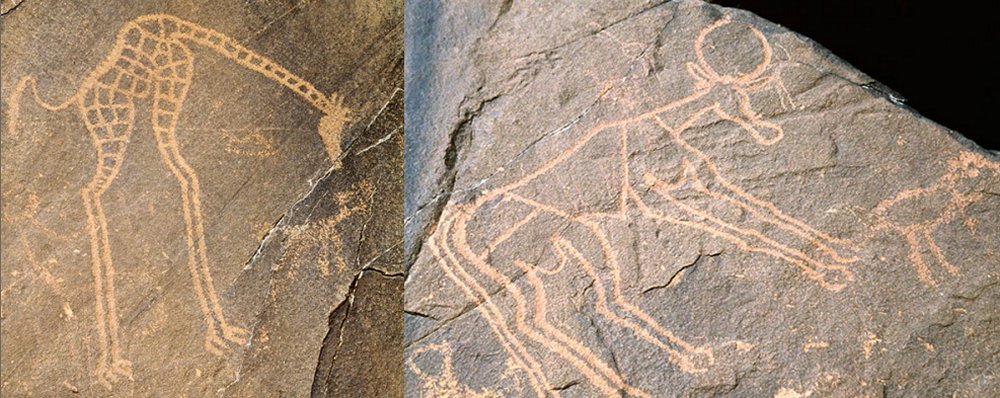
Rock art in form of carvings and paintings of mostly animals and vegetation and dated 3,500 to 2,500 BC, was found in the Aïr Mountains in northeastern Niger, not far from the city of Djado. Image credit: africanrockart.org
Another reason might be that cattle herding in the region also introduced mosquitoes that spread malaria. In 1860, about 1000 Kanuri are said to have been left. In the middle of the 20th century, only a few Kanuri and Toubou were left. They mostly lived from growing dates and harvesting salt.
The region of Niger and this part of the Sahara has revealed considerable archaeological evidence that about 60,000 years ago, humans inhabited what has since become the desolate Sahara Desert of northern Niger.
 Ancient ruins of Djado. Image credit: freevst.x10.mx
Ancient ruins of Djado. Image credit: freevst.x10.mx
From at least 7,000 BC, inhabitants of these vast fertile grasslands were busy raising livestock, herding sheep and goats, and leaving large settlements and pottery. Cattle were introduced to the region approximately from 4,000 to 3,500 BC.
Rock art in the form of carvings and paintings of primarily animals and vegetation and dated 3,500 to 2,500 BC was found in the Aïr Mountains in northeastern Niger, not far from the city of Djado.
Written by – A. Sutherland - AncientPages.com Senior Staff Writer
Copyright © AncientPages.com All rights reserved. This material may not be published, broadcast, rewritten or redistributed in whole or part without the express written permission of AncientPages.com
Expand for referencesMore From Ancient Pages
-
 Unexplained Mystery Of The Untraceable Stone-Throwers – Strangeness In North America, Belgium And Indonesia – Part 1
Featured Stories | Nov 11, 2019
Unexplained Mystery Of The Untraceable Stone-Throwers – Strangeness In North America, Belgium And Indonesia – Part 1
Featured Stories | Nov 11, 2019 -
 Bizarre Story Of Scottish Penkaet Castle
Featured Stories | Apr 18, 2020
Bizarre Story Of Scottish Penkaet Castle
Featured Stories | Apr 18, 2020 -
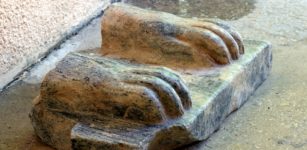 Fragment Of Unique Egyptian Sphinx Unearthed In North Israel
Archaeology | Jul 13, 2013
Fragment Of Unique Egyptian Sphinx Unearthed In North Israel
Archaeology | Jul 13, 2013 -
 Were Medieval Philosophers Familiar With The Multiverse Theory?
Featured Stories | Oct 4, 2018
Were Medieval Philosophers Familiar With The Multiverse Theory?
Featured Stories | Oct 4, 2018 -
 On This Day In History: Joan Of Arc Was Captured By The Burgundians – On May 23, 1430
News | May 23, 2016
On This Day In History: Joan Of Arc Was Captured By The Burgundians – On May 23, 1430
News | May 23, 2016 -
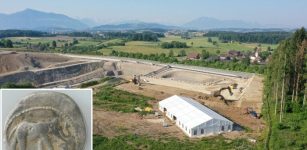 Why Are The 2,000-Year-Old Roman Walls Found In Switzerland An ‘Archaeological Sensation’?
Archaeology | Sep 15, 2023
Why Are The 2,000-Year-Old Roman Walls Found In Switzerland An ‘Archaeological Sensation’?
Archaeology | Sep 15, 2023 -
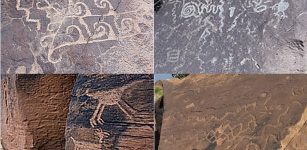 Lyman Lake Petroglyphs And Famous Kokopelli-Flute Player Left By Ancestors Of The Hopi Indians
Civilizations | Nov 26, 2018
Lyman Lake Petroglyphs And Famous Kokopelli-Flute Player Left By Ancestors Of The Hopi Indians
Civilizations | Nov 26, 2018 -
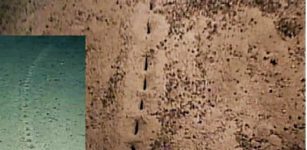 Who Or What Made These Mysterious Holes At The Bottom Of The Atlantic Ocean?
News | Mar 23, 2023
Who Or What Made These Mysterious Holes At The Bottom Of The Atlantic Ocean?
News | Mar 23, 2023 -
 Impressive Textile Reconstruction Shows What Viking Age People Dressed Like
Featured Stories | Sep 26, 2023
Impressive Textile Reconstruction Shows What Viking Age People Dressed Like
Featured Stories | Sep 26, 2023 -
 Oldest Evidence Of Beer Comes From Raqefet Cave, Dating Back To 11,000 B.C.
Archaeology | Sep 27, 2024
Oldest Evidence Of Beer Comes From Raqefet Cave, Dating Back To 11,000 B.C.
Archaeology | Sep 27, 2024 -
 Huge 1,400-Year-Old Hall Of The First Kings Of East Anglia Discovered In Rendlesham
Archaeology | Oct 5, 2022
Huge 1,400-Year-Old Hall Of The First Kings Of East Anglia Discovered In Rendlesham
Archaeology | Oct 5, 2022 -
 New Giant Geoglyph Of Orca With Mysterious Symbols And A ‘Trophy Head’ Found In Nazca Lines
Archaeology | Nov 18, 2017
New Giant Geoglyph Of Orca With Mysterious Symbols And A ‘Trophy Head’ Found In Nazca Lines
Archaeology | Nov 18, 2017 -
 Neanderthals’ Lack Of Drawing Ability Could Explain Why Modern Humans Became Smarter
Archaeology | Feb 11, 2018
Neanderthals’ Lack Of Drawing Ability Could Explain Why Modern Humans Became Smarter
Archaeology | Feb 11, 2018 -
 Ancient Venetian Merchants Were Always Prepared For The Worst
Featured Stories | Jul 12, 2024
Ancient Venetian Merchants Were Always Prepared For The Worst
Featured Stories | Jul 12, 2024 -
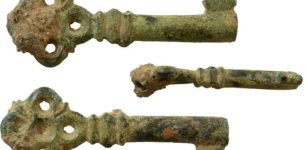 Intriguing Beautiful Medieval Key Discovered In Claverham Village, UK
Artifacts | Oct 10, 2023
Intriguing Beautiful Medieval Key Discovered In Claverham Village, UK
Artifacts | Oct 10, 2023 -
 Home Of The Gods – Arrival Of Golden Ships – Part 1
Ancient Mysteries | Jun 12, 2018
Home Of The Gods – Arrival Of Golden Ships – Part 1
Ancient Mysteries | Jun 12, 2018 -
 Sumerian ‘Mask Of Warka’ From Uruk: Sculptured Face May Depict Goddess Inanna
Featured Stories | Sep 15, 2016
Sumerian ‘Mask Of Warka’ From Uruk: Sculptured Face May Depict Goddess Inanna
Featured Stories | Sep 15, 2016 -
 What Were Victorian Bathing Machines?
Ancient History Facts | Jun 9, 2018
What Were Victorian Bathing Machines?
Ancient History Facts | Jun 9, 2018 -
 Famous Ancient Hittite Figures And Symbols Engraved In Stone By A Local Artist From Çorum Province, Anatolia
News | Aug 8, 2020
Famous Ancient Hittite Figures And Symbols Engraved In Stone By A Local Artist From Çorum Province, Anatolia
News | Aug 8, 2020 -
 Is The Tomb Of Genghis Khan Hidden And Protected In The Khentii Mountains Because Some Fear It’s Cursed?
Featured Stories | Jul 16, 2021
Is The Tomb Of Genghis Khan Hidden And Protected In The Khentii Mountains Because Some Fear It’s Cursed?
Featured Stories | Jul 16, 2021


